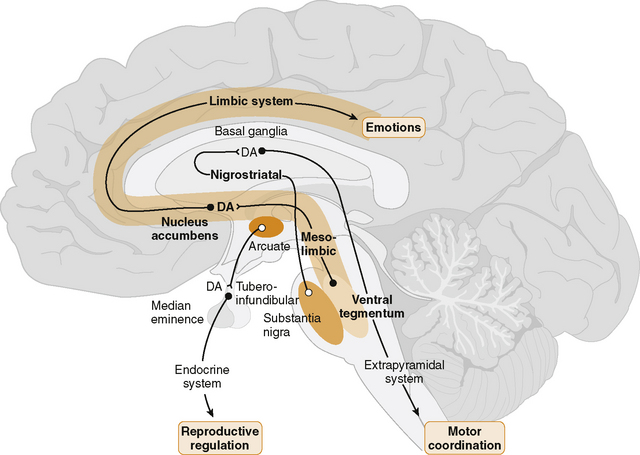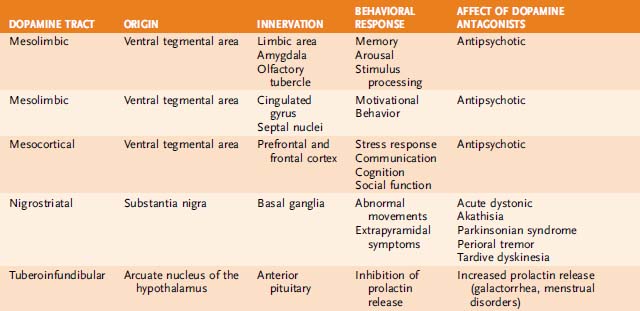Chapter 10 Psychotherapeutic Drugs
2. These drugs reduce positive symptoms (e.g., paranoia, hallucinations, delusions) more than negative symptoms (e.g., emotional blunting, poor socialization, cognitive deficit) in patients with schizophrenia.
3. The newer “atypical” antipsychotics are more effective, especially against negative symptoms, and less toxic than the older but less expensive conventional antipsychotics.
4. Late in 2003, the U.S. Food and Drug Administration (FDA) requested all manufacturers to include product label warnings about the potential for an increased risk of hyperglycemia and diabetes with the use of “atypical” antipsychotics.
5. April 2005, FDA issued a boxed warning that “atypical” antipsychotics increased risk of death in patients treated with certain “atypical” antipsychotics for dementia-related behavioral disorders.
6. June 2008, this boxed warning was extended to conventional antipsychotics (e.g., haloperidol, fluphenazine) as well.
4. Haloperidol (every 4 weeks) and fluphenazine (every 2 weeks) decanoate salts are available as depot preparations for noncompliant patients.
1. All antipsychotics alter dopamine pathways; the antipsychotic activity correlates best with changes in mesolimbic and mesocortical pathways where adverse effects are often due to changes in nigrostriatal and tuberoinfundibular pathways (Table 10-2 and Fig. 10-1)
TABLE 10-1 Mechanisms and Effects of Neuroleptic Agents
| Mechanism | Action |
|---|---|
| Blockade of dopamine D1 and D2 receptors | Antipsychotic, extrapyramidal, and endocrine effects |
| Blockade of α-adrenergic receptors | Hypotension, failure to ejaculate |
| Blockade of histamine H1 receptors | Sedation |
| Blockade of muscarinic receptors | Anticholinergic effects (e.g., dry mouth, urinary retention) |
| Blockade of serotonin receptors | Antipsychotic effects |

(From Kester M, et al.: Elsevier’s Integrated Pharmacology. Philadelphia, Mosby, 2007, Figure 13-6.)
• The actions of the neuroleptic agents in the mesolimbic and mesocortical pathways are most important for their antipsychotic effects.
(2) Avoid giving these drugs to patients who are undergoing withdrawal from central nervous system (CNS) depressants.
(a) Blocks serotonin and dopamine (especially, D1 and D4) receptors, with a greater effect on the serotonin receptors (5-hydroxytryptamine [5-HT2A])
(c) Has a greater effect on negative symptoms of schizophrenia than the older conventional antipsychotics
(b) High incidence of agranulocytosis (1−2%), which necessitates regular (weekly) complete blood counts (CBCs)
• Newer “atypical” antipsychotic agent structurally similar to clozapine, a dibenzodiazepine structure
Stay updated, free articles. Join our Telegram channel

Full access? Get Clinical Tree




